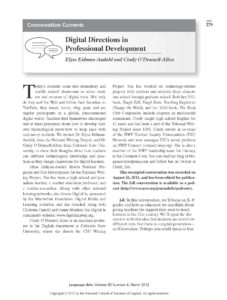Author: Elyse Eidman-Aadahl and Cindy O’Donnell-Allen
Summary: In a conversation sponsored by NCTE’s Language Arts, two NWP leaders discuss the transformations in the classroom and in teacher practice that happen when connected learning and digital tools are integrated into curriculum planning. They emphasize that the tools do not replace the teacher; the teacher becomes even more important as a model, or “lead learner,” for writing in today’s digital age.
Original Date of Publication: June 20, 2012
Excerpt
Elyse: I think that, of course, there are some big fundamental elements of human beings that don’t change, so there are lots of elements of young kids today that are the same as young people over time. I don’t want to make too much of this conversation that kids today are different—there is much about youth that is unchanged. But in this visual era surrounded by media and information and being connected to the Internet and a million devices, we shouldn’t be surprised to see some impact on young people and to have the sense that young people coming into our schools are, in some ways, different.
The kids we see coming into schools today are used to having agency in the world. They are used to pushing a button and having something happen. They are used to having a question and being able to get an answer to it really fast. They are used to multitasking several things at one time. I don’t think these are necessarily bad things. We are in a conversation right now as a culture about the impact of this huge shift in the environment — the communications environment that we are in, the information environment — and a lot of people are worried about some downsides. There are also some pretty powerful ways that we might be expanding potential and expanding cognition at the same time. Young people are in the middle of it, so I think it is true that they do show up in schools behaving and thinking and moving at a pace that is different than kids 10 or 20 years ago.
Cindy: So, you hear the phrase, “the more things change, the more they stay the same.” I think that is true, but those lines between what we are asking them to do inside of school and outside of school have remained pretty strong. What I would like us to do is to think about how exciting it could be if we blurred those lines more frequently and more deliberately, perhaps more than they have been in earlier years when print-based texts were really ruling the world. We’ve always had technology with us — a pencil is technology, a pen is a kind of technology. Now we have this opportunity to look at other tools that technology provides and to think, “Wow, what can I do with a computer, with a digital camera, with a device that captures my voice that I wouldn’t be able to do if I were just using pen and paper alone?”
That, I believe, is really, really exciting, and it’s a way that teachers can realize they still matter in the world. We’re the ones that have more experience than the kids do about issues like purpose and context and the content of what kids are trying to say and who their audience might be. We can help them think about the best genre to choose. Does it make sense to break out a pencil and paper? Does it make sense to go online and blog about whatever it is I want to say?
I think it’s a cool thing for us as teachers to realize, too. We are still central. There are things that we know how to do, regardless of how many gadgets the kids know how to use that we aren’t able to use at the moment. We still have the knowledge to help them say what they want to say in a way that is appropriate for whatever their message is.
Listen to the Conversation
Duration: 36 minutes
Related Resources
- Because Digital Writing Matters: A Conversation with the Authors
- Teacher Discoveries and Connected Learning
- Introduction: Why Digital Writing Matters
Original Source: National Writing Project, https://www.nwp.org/cs/public/print/resource/3861
Copyright © 2012 National Council of Teachers of English. Reprinted with Permission.
Eidman-Aadahl, Elyse and Cindy O’Donnell-Allen. “Digital Directions in Professional Development” Language Arts 89.4 (2012): pp. 279-284
